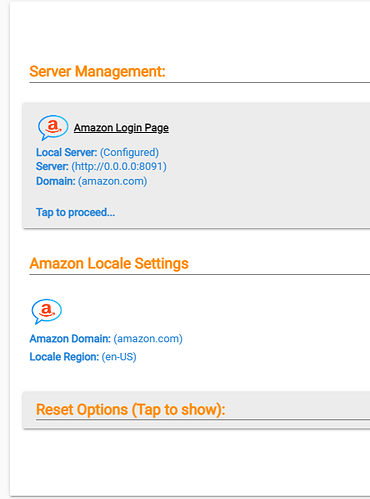Thanks @terminal3. I scrolled up looking for something, but not far enough apparently.
I installed with 4.2.08 from scratch yesterday and had no issue using the docker container but for the one mandatory restart.
I did the same thing. I paid the 5.00 subscription fee. I have no issue paying for a month or two while Tonesto gets a replacement in place or I build my own Raspbery PI server during the 2 week Holiday break coming up next month.
I just deployed my local server with Portainer. I had to restart the container a couple times to get ES to recognize that the server had logged into Amazon and fetched the cookie. But it seems to be working as intended now.
Thank you @tonesto7 for all the hard work you've put into this. Sent another Paypal donation your way ![]() .
.
Who else hasn't donated recently? ![]()
When I try to get echo-speaks-server running in a Docker container on my Synology NAS the Hubitat app assigns the IP as 0.0.0.0. I have the Docker container using Host. I'm sure why this is happening?
Looks correct, is there an issue?
I've been running a local server for awhile now and I have HPM set to auto update. Echo Speaks auto updated to v4.2.0.8 and so far I haven't seen any issues.
Would you mind sharing detailed instructions on how to get it set up through your synology. I hope to get it installed and working on a new DS220+. Never used Docker or SSH before and a lot of what I'm reading is scattered and confusing.
The Hubitat app has the server IP set to http://0.0.0.0:8091, but it should be http://192.168.4.3:8091. What's strange is ES was still able to retrieve the Amazon cookie and discover my Alexa devices.
It's not a critical update mostly UI, but either way it won't affect your current install if you do update
Agreed. I can spend $275 on a new RPi and case and set this up. Or I can spend $5 a month for several months and see how this plays out.
Well said!
If you have ANY always on machines, Linux, Windows, NAS, etc... you can just pop docker on there and install his container. Does not have to be a RPi, in fact you can get way more power from a regular mini-PC for around the same prices.
Side Note, I already had the server installed from the github repo from my initial setup. Once I remembered how to update it I just had to go to the directory and run:
npm install tonesto7/echo-speaks-server
Restarted the pm2 service and its all set.
What he said. I have mine running on a laptop running ubuntu, ANY cheap old laptop can run ubuntu and do this, no need for docker usually
I have been monitoring this thread for the past several months as I have been using the Alexa TTS solution for simple notifications. I knew about Echo Speaks from my ST days but the Heroku requirement was a non-starter for me for many reasons that aren't important for this discussion.
Now that things are local I took the plunge and installed this on my NAS yesterday and app installed on my Dev server to test things out. Well worth the time and like @marktheknife I also bought @tonesto7 a case of beer/adult beverage(s) for his continued community support via Paypal donation.
I did update as well..
I had followed instructions from here
I was running local server since a couple of weeks.. and it auto updated to 4.2.0.8 and seems to be working fine so far..
@tonesto7 Hey, I picked up with the "how to" guide. Great work. I ended up with the node.js install in a LXD container.
I was wondering if someone could weigh in on this before I commit the time/effort.
After reading a bit on this thread, I have decided to try to run ES Server locally by setting up a VM using VirtualBox that is running Ubuntu and then installing the Server. I will be following @vmsman instructions that he posted a few weeks ago, earlier in this thread.
I currently have an always-on Windows (10 Pro) machine, which currently runs 6 IP cameras in Blue Iris and Plex Media Server. The specs are: i7-4770 CPU @ 3.40 Ghz, 32 GB RAM and basic on-board video card.
My questions are:
-
Is VirtualBox running a VM with Ubuntu too resource intensive, considering what I am already using my machine for? Currently, when Blue Iris is running as a Service, I am under 30% CPU utilization.
-
With the changes that have been made to ES, is this still a good way to setup/run the ES Local Server on a Windows machine?
Thanks in advance for any insights/advice.
@JimB34m I think that your approach is viable. Virtual Machines are always much more intensive on resources than containers. Since you have Windows 10 Pro, a better way to lighten the load would be to use the Hyper-V Hypervisor as opposed to VirtualBox. Hyper-V is more efficient as a Hypervisor. I would install the VM as Ubuntu 22.04 Server and not desktop. I would strongly advise configuring LXD containers inside of the Ubuntu Server VM. This will provide the ability to use that VM to install many isolated apps in the single VM. If you would like to discuss this, come by my chat at https://chat.scottibyte.com/.
A real OS is something Like IBMi, AIX, or VMS.






